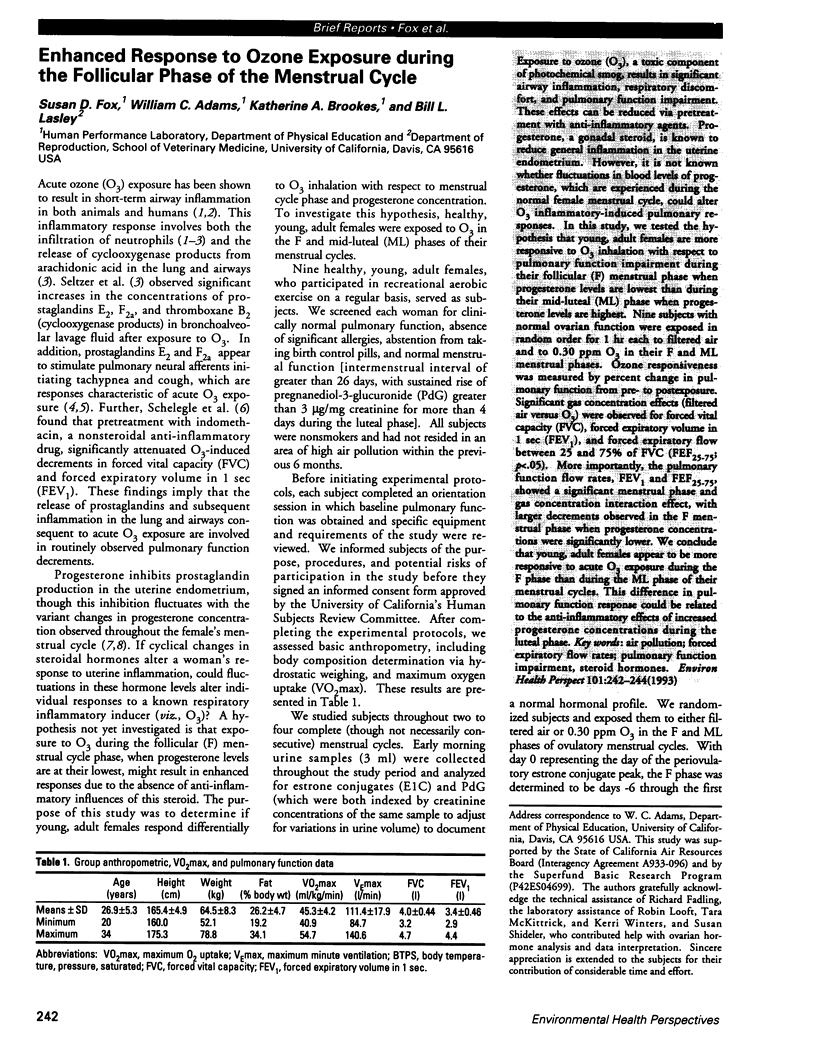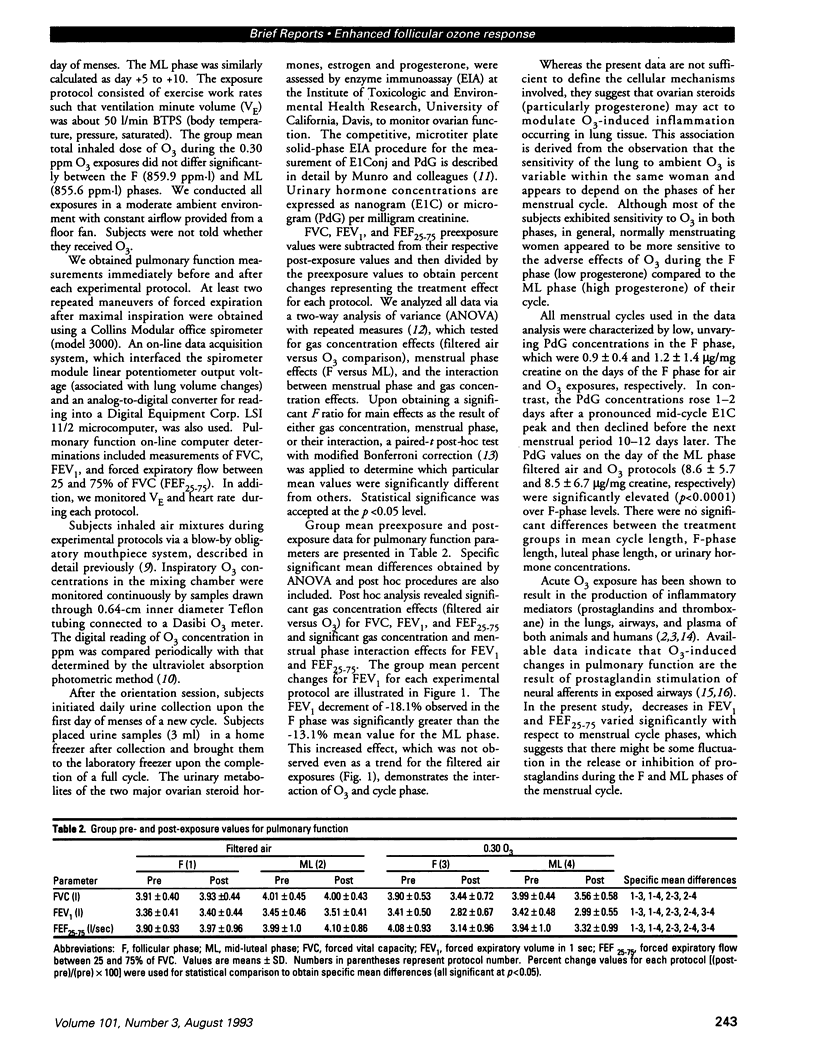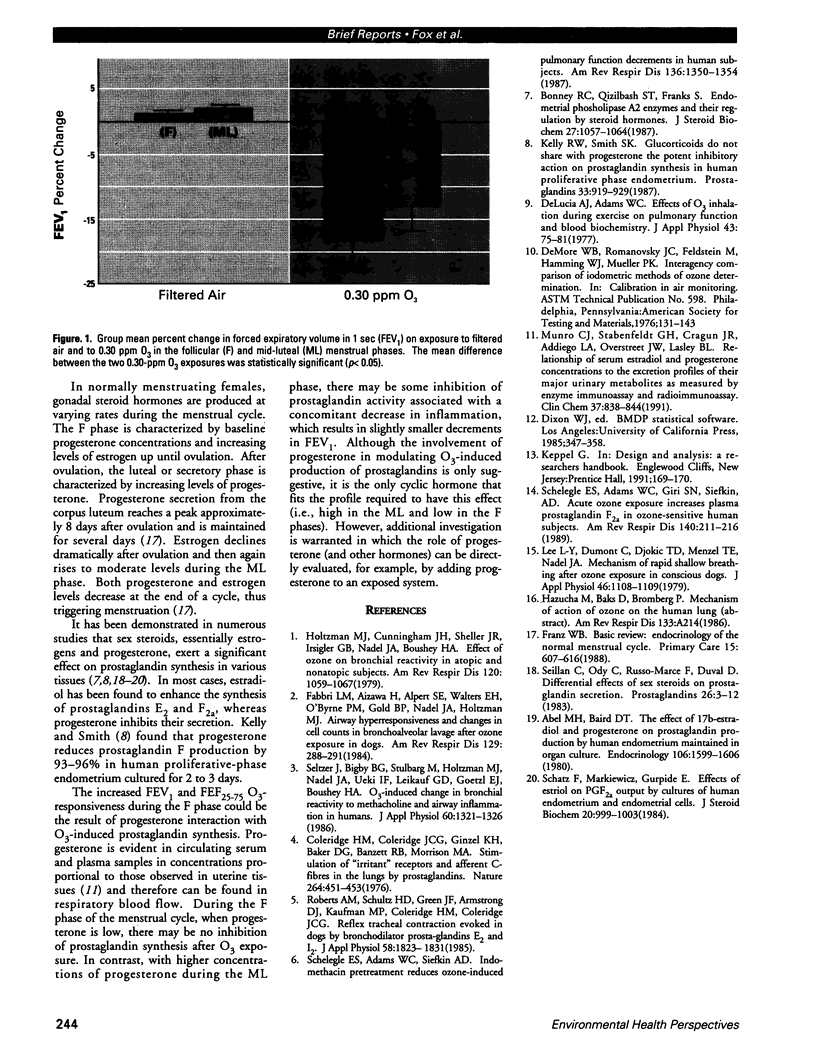Abstract
Exposure to ozone (O3), a toxic component of photochemical smog, results in significant airway inflammation, respiratory discomfort, and pulmonary function impairment. These effects can be reduced via pretreatment with anti-inflammatory agents. Progesterone, a gonadal steroid, is known to reduce general inflammation in the uterine endometrium. However, it is not known whether fluctuations in blood levels of progesterone, which are experienced during the normal female menstrual cycle, could alter O3 inflammatory-induced pulmonary responses. In this study, we tested the hypothesis that young, adult females are more responsive to O3 inhalation with respect to pulmonary function impairment during their follicular (F) menstrual phase when progesterone levels are lowest than during their mid-luteal (ML) phase when progesterone levels are highest. Nine subjects with normal ovarian function were exposed in random order for 1 hr each to filtered air and to 0.30 ppm O3 in their F and ML menstrual phases. Ozone responsiveness was measured by percent change in pulmonary function from pre- to postexposure. Significant gas concentration effects (filtered air versus O3) were observed for forced vital capacity (FVC), forced expiratory volume in 1 sec (FEV1), and forced expiratory flow between 25 and 75% of FVC (FEF25-75; p < .05). More importantly, the pulmonary function flow rates, FEV1 and FEF25-75, showed a significant menstrual phase and gas concentration interaction effect, with larger decrements observed in the F menstrual phase when progesterone concentrations were significantly lower. We conclude that young, adult females appear to be more responsive to acute O3 exposure during the F phase than during the ML phase of their menstrual cycles.(ABSTRACT TRUNCATED AT 250 WORDS)
Full text
PDF


Images in this article
Selected References
These references are in PubMed. This may not be the complete list of references from this article.
- Abel M. H., Baird D. T. The effect of 17 beta-estradiol and progesterone on prostaglandin production by human endometrium maintained in organ culture. Endocrinology. 1980 May;106(5):1599–1606. doi: 10.1210/endo-106-5-1599. [DOI] [PubMed] [Google Scholar]
- Bonney R. C., Qizilbash S. T., Franks S. Endometrial phospholipase A2 enzymes and their regulation by steroid hormones. J Steroid Biochem. 1987;27(4-6):1057–1064. doi: 10.1016/0022-4731(87)90190-7. [DOI] [PubMed] [Google Scholar]
- Coleridge H. M., Coleridge J. C., Ginzel K. H., Baker D. G., Banzett R. B., Morrison M. A. Stimulation of 'irritant' receptors and afferent C-fibres in the lungs by prostaglandins. Nature. 1976 Dec 2;264(5585):451–453. doi: 10.1038/264451a0. [DOI] [PubMed] [Google Scholar]
- DeLucia A. J., Adams W. C. Effects of O3 inhalation during exercise on pulmonary function and blood biochemistry. J Appl Physiol Respir Environ Exerc Physiol. 1977 Jul;43(1):75–81. doi: 10.1152/jappl.1977.43.1.75. [DOI] [PubMed] [Google Scholar]
- Fabbri L. M., Aizawa H., Alpert S. E., Walters E. H., O'Byrne P. M., Gold B. D., Nadel J. A., Holtzman M. J. Airway hyperresponsiveness and changes in cell counts in bronchoalveolar lavage after ozone exposure in dogs. Am Rev Respir Dis. 1984 Feb;129(2):288–291. [PubMed] [Google Scholar]
- Franz W. B., 3rd Basic review: endocrinology of the normal menstrual cycle. Prim Care. 1988 Sep;15(3):607–616. [PubMed] [Google Scholar]
- Holtzman M. J., Cunningham J. H., Sheller J. R., Irsigler G. B., Nadel J. A., Boushey H. A. Effect of ozone on bronchial reactivity in atopic and nonatopic subjects. Am Rev Respir Dis. 1979 Nov;120(5):1059–1067. doi: 10.1164/arrd.1979.120.5.1059. [DOI] [PubMed] [Google Scholar]
- Kelly R. W., Smith S. K. Glucocorticoids do not share with progesterone the potent inhibitory action on prostaglandin synthesis in human proliferative phase endometrium. Prostaglandins. 1987 Jun;33(6):919–929. doi: 10.1016/0090-6980(87)90119-5. [DOI] [PubMed] [Google Scholar]
- Lee L. Y., Dumont C., Djokic T. D., Menzel T. E., Nadel J. A. Mechanism of rapid, shallow breathing after ozone exposure in conscious dogs. J Appl Physiol Respir Environ Exerc Physiol. 1979 Jun;46(6):1108–1114. doi: 10.1152/jappl.1979.46.6.1108. [DOI] [PubMed] [Google Scholar]
- Munro C. J., Stabenfeldt G. H., Cragun J. R., Addiego L. A., Overstreet J. W., Lasley B. L. Relationship of serum estradiol and progesterone concentrations to the excretion profiles of their major urinary metabolites as measured by enzyme immunoassay and radioimmunoassay. Clin Chem. 1991 Jun;37(6):838–844. [PubMed] [Google Scholar]
- Roberts A. M., Schultz H. D., Green J. F., Armstrong D. J., Kaufman M. P., Coleridge H. M., Coleridge J. C. Reflex tracheal contraction evoked in dogs by bronchodilator prostaglandins E2 and I2. J Appl Physiol (1985) 1985 Jun;58(6):1823–1831. doi: 10.1152/jappl.1985.58.6.1823. [DOI] [PubMed] [Google Scholar]
- Schatz F., Markiewicz L., Gurpide E. Effects of estriol on PGF2 alpha output by cultures of human endometrium and endometrial cells. J Steroid Biochem. 1984 Apr;20(4B):999–1003. doi: 10.1016/0022-4731(84)90010-4. [DOI] [PubMed] [Google Scholar]
- Schelegle E. S., Adams W. C., Giri S. N., Siefkin A. D. Acute ozone exposure increases plasma prostaglandin F2 alpha in ozone-sensitive human subjects. Am Rev Respir Dis. 1989 Jul;140(1):211–216. doi: 10.1164/ajrccm/140.1.211. [DOI] [PubMed] [Google Scholar]
- Schelegle E. S., Adams W. C., Siefkin A. D. Indomethacin pretreatment reduces ozone-induced pulmonary function decrements in human subjects. Am Rev Respir Dis. 1987 Dec;136(6):1350–1354. doi: 10.1164/ajrccm/136.6.1350. [DOI] [PubMed] [Google Scholar]
- Seillan C., Ody C., Russo-Marie F., Duval D. Differential effects of sex steroids on prostaglandin secretion by male and female cultured piglet endothelial cells. Prostaglandins. 1983 Jul;26(1):3–12. doi: 10.1016/0090-6980(83)90069-2. [DOI] [PubMed] [Google Scholar]
- Seltzer J., Bigby B. G., Stulbarg M., Holtzman M. J., Nadel J. A., Ueki I. F., Leikauf G. D., Goetzl E. J., Boushey H. A. O3-induced change in bronchial reactivity to methacholine and airway inflammation in humans. J Appl Physiol (1985) 1986 Apr;60(4):1321–1326. doi: 10.1152/jappl.1986.60.4.1321. [DOI] [PubMed] [Google Scholar]



